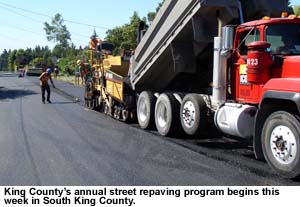|
|
County smoothing out the process for sidewalks and
streets
 Our
late spring rain may be putting a damper on the schedule, but crews from
the King County Road
Services Division are excited about recent innovations that are
smoothing out the process for laying asphalt and cement. Our
late spring rain may be putting a damper on the schedule, but crews from
the King County Road
Services Division are excited about recent innovations that are
smoothing out the process for laying asphalt and cement.
If the weather permits, county crews will begin the annual street
repaving program this week in South King County, while another crew is
waiting for some sunshine to pour curbs and gutters on a
first-of-its-kind project near Woodinville. Both projects involve new
techniques and materials that should save time and money.
This summer, the county will be repaving approximately 63 center lane
miles of roadway mostly in unincorporated King County and also in a few
contract cities. The total cost for 2006 paving is $6.6 million. The
first road on the overlay schedule is Cedar Grove Road south of Issaquah
for the South County program. The North County program will start about
a week later in Shoreline and work its way clockwise through the north
and east parts of the county. To track the work of the paving crews,
visit the
overlay project webpage.
 Saving
money couldn’t come at a better time for the county paving program. As
petroleum prices soar, so do the cost of related products such as
asphalt. This year, the county will be paying almost $10 a ton more for
asphalt than in 2005. A very costly price hike when you consider that
the county will be purchasing a total of 124,000 tons of asphalt this
summer just for the overlay program. Saving
money couldn’t come at a better time for the county paving program. As
petroleum prices soar, so do the cost of related products such as
asphalt. This year, the county will be paying almost $10 a ton more for
asphalt than in 2005. A very costly price hike when you consider that
the county will be purchasing a total of 124,000 tons of asphalt this
summer just for the overlay program.
“Petroleum-based products like asphalt have gone sky high, so we’re
looking at ways to be as efficient as possible with our available
dollars,” said Rick Brater, Engineering Services Section manager. “We
are using monies saved through efficiencies to do the most we can to
preserve the road systems in the unincorporated areas.”
Last summer, the Roads Division staff implemented two new items to the
paving program to allow for more efficient paving and a more durable
pavement surface. Both will return again this year based on last year’s
success. One involves placing a material transfer device between the
paving machine and the large trucks carrying the asphalt. The transfer
device holds more than a truckload of asphalt and continuously mixes the
hot asphalt to allow for non-stop paving that speeds up the process and
creates a new surface with fewer lumps and bumps caused by short-term
stops and starts.
The other innovation was buying a different type of asphalt mix called
“Super Pave,” which is longer lasting requiring less frequent repaving
on the same stretch of road. Brater said the division is also looking at
varying the thickness of the overlay on roads that don’t have heavy
truck travel as another way to make the asphalt go further.
Most of the resurfacing is done in short stretches, with priority given
to key arterials and busy residential streets. Laying down a new coat of
asphalt not only improves driving surfaces, but it also reduces
maintenance costs and extends the life of the roads.
In another innovative application, the Roads Division is also exploring
how it can use slag cement, a by-product of steel production, in some of
its projects – particularly sidewalks, curbs and gutters. Mixed in with
other materials to form fresh concrete, it saves on the cost of brand
new cement and reuses materials that were once sent straight to the
landfill.
 It
is being used for the first time by the county on a walkway project near
Hollywood Hills Elementary east of Woodinville. The slag cement will be
used on the curb and gutter next to the roadway, and on the back curb
next to a hillside. It
is being used for the first time by the county on a walkway project near
Hollywood Hills Elementary east of Woodinville. The slag cement will be
used on the curb and gutter next to the roadway, and on the back curb
next to a hillside.
Slag is a by-product generated in the blast furnaces used to produce
steel. Once a waste material, slag is becoming increasingly useful as a
substitute for up to 50 percent of the portland cement used to make
concrete. This substitution can reduce greenhouse gas emissions because
slag is a by-product of the energy already used to produce steel. The
division’s Roads Material lab conducted a full battery of tests on
different slag blends and applications to determine their suitability
and usability on King County road and infrastructure projects.
Roads staff wanted to experiment with the slag cement first on a small
scale project like the walkway out at Hollywood Hills to see how the
finishing and curing works. The report from the lab testing was that it
seems to take a little longer to harden, but takes less work to get a
smooth finish and ends up stronger as it cures. It also has a lighter
color than regular cement.
Now that the testing is done, the crews are ready to try it out in the
field – if the rain ever stops long enough.
|


